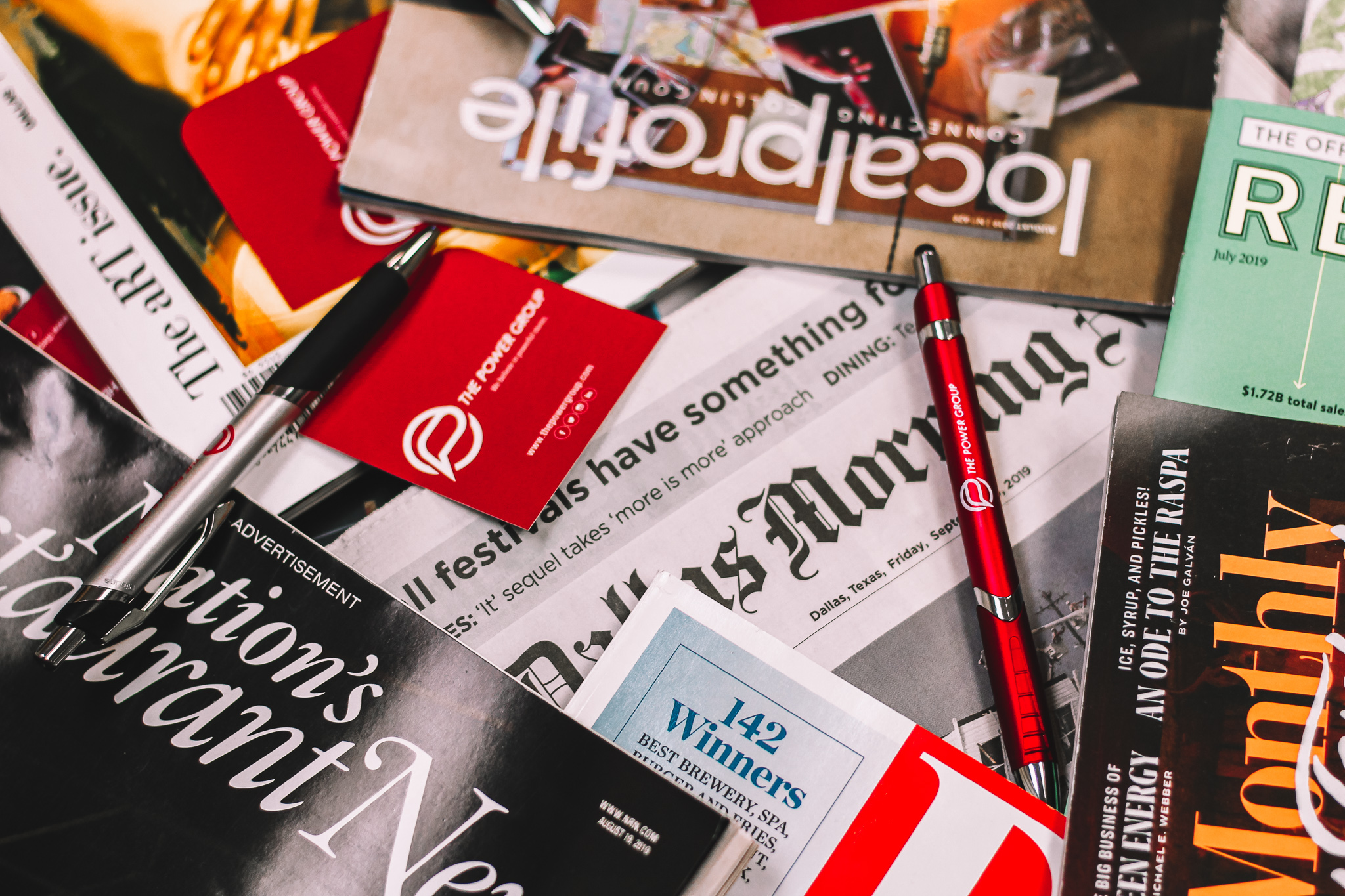Welcome to our new blog series, Sound Off! We ask three experts from the same industry three questions and give them the opportunity to sound off.
Like many other industries, news stations and publications are experiencing difficulties and having to change their daily operations. For part one of our series, we asked local DFW reporters about the changes and impact they are experiencing and how the public can support their mediums.
The Power Group: How has the day-to-day life of being a reporter changed for you?
Christine Perez, Editor at D CEO: Understanding that our mission of connecting readers is more important than ever, we have ramped up our online coverage, focusing on our D CEO Healthcare vertical, D CEO Real Estate vertical, and general business news at our main D CEO site. Initial data shows our online readership across all platforms is up substantially. At the same time, we just sent our May issue to press; it’s the first one we have produced remotely. It went remarkably well. We decided halfway through production to add four pages and create a special COVID-19 report that includes perspectives from 20+ executives across all industries. We leveraged some web content for the section, and we also leveraged section content to create a new web series called Executive Perspectives. The other editors and I have daily meetings via Microsoft Teams to touch base and share story ideas, etc., and we created a OneDrive document that we share with other D Magazine Partners editors so we can create awareness about what we’re all working on and make sure there’s no duplication of effort. This kind of communication used to take place in person, in the newsroom. We are still able to do the interviews we need to do—executives have been even more accessible than ever, it seems. Our big challenge for our June issue will be photography.
Sonia Azad, WFAA Health & Wellness Reporter: Life has changed a great deal. Most glaring: I work from home. I started this new rhythm about a month ago. So, instead of going into the studio each morning, I have a mini broadcast set up in the kitchen area of my apartment. Each morning, I wake up at 4am to turn on my own lights, wire myself with a microphone and dial into IFB on my iPhone – so that I can hear programming in my ear – and then broadcast through an app from an iPad that is set up on a tripod. All of my interviews are done remotely now. So, no more in-person stuff. I use either Zoom or Skype to conduct those interviews. My photographer is pregnant, so she is working from her home as well – and is not allowed to come to my apartment to help with story editing. I have a voice recorder that I use to track my voice for recorded stories – so that she can edit my voice onto images (video and graphics) for our pieces that air on WFAA. To do this, I use a pillow-fort style setup in my room to create an “audio booth” so that the sound isn’t echoey. Then I record my voice onto an SD card, use an adapter to load the file onto my laptop and email the MP4 to my photographer who remotely edits and sends the final product into the station. If you saw what I go through to shoot a simple standup by myself and sync the video and audio, you’d laugh. But hey, we’re making it work! I have a love-hate relationship with technology.
Jeff Schnick, Editor in Chief at Dallas Business Journal: Journalism is a face-to-face business. It’s certainly strange to conduct it only by phone, video call or email and not be in the same room with the executive we’re interviewing. In the digital age, everyone has a laptop and a cell phone, so in a 24-7 news environment, we’ve all been working remotely for years. In terms of hours, it’s nice to get the commute time back for work, but the hours are still longer each day because there is so much news to cover with the pandemic, but also all of the typical stories people would expect from us, such as mergers, promotions and the like. But we’re no different than any other industry that has had to make adjustments – and at least we have the option of working at a distance, or choosing when we do interviews in person as needed. First responders, health care workers on the front line and grocery store employees don’t have that luxury, which is why it’s more important than ever to share their stories with North Texas.
TPG: What kind of long-term impact do you envision COVID having on the communications and news industry?
CP: I think we will all do more work from home, as it has gone so well, so far. I live just a few blocks from D and walk to work, so it’s no big deal for me to go to the office, but others are loving not having a commute. For the first time, we’re making entire issues of D CEO available in digital form—in addition to print. It has been fun to see the engagement of people (number of readers and time spent reading the issue) and how we’ve been able to introduce the publication to a wider audience. We’re lucky that we have both digital and magazine platforms; not only are we able to reach different readership groups, editors have the opportunity to do both news reporting and long-form journalism, which is rare. As a magazine company, we haven’t been hit by the media industry evolution as much as newspapers have. We’ve experienced consistent growth for quite a while, both in revenue and in the number of employees—until COVID-19 struck. Our digital platform has no paywalls; that has been an advantage for us, in terms of readership. The media play such a critical role in our society. It hurts to see newsrooms shrinking and publications folding. I do believe that people will be willing to pay for information that’s important to them and that advertisers will continue to want to reach targeted audiences.
SA: Because the virus is still so new, it’s really hard to say how it may impact any of our lives long term – including news/ television. I do now see the large scale work-from-home model as a viable backup plan in the event of a public health crisis or weather emergency or any other big breaking news that would prohibit some of us from getting “into” the station. As far as working out in the field: I think protocol will change with regard to keeping equipment sanitized and clean. We are so quick to share microphones and cameras and batteries and wires etc. The awareness of this new virus forces us all to be more mindful of those old habits – and to adapt. I don’t think CoVid will stop us from being able to do our jobs, but I do think that we will have to continue to be resourceful and creative in how we gather elements for storytelling and interviews – in order to keep sharing relevant information with our audiences in the safest manner possible.
JS: It would be my hope that we never forget that our relationship with our readers – and the broader community – has always been our strongest asset and resource. No one gets into journalism to sell products or help brands with messaging: That’s the role of marketers and PR folks. You don’t choose journalism so much as it chooses you. I can’t envision doing anything else because you get to make a difference. In the best situations with certain topics, you’re offered a chance to help your community thrive. That doesn’t mean you only report what people prefer or what makes them look good; it’s our job to offer our readers the unvarnished truth. That’s who we serve – and always will. And your readers, not the editors or reporters, are the ones who determine whether or not your product is relevant, timely and makes a difference in their lives. North Texas has a very diverse media sector, from newspapers and TV to magazines and radio – and I think that serves the community now and will position our industry locally very well for the future.
TPG: What is the best way for the general public to support the news industry right now?
CP: Follow trusted sources. Read and subscribe!
SA: This is a really fantastic question. Thank you for asking. Right now, the best thing to do is: 1. Educate yourself about the difference between national network news and local news. It’s important to distinguish between reporters and analysts (“talking heads”). Local news isn’t in the business of offering opinions, outside of a columnist or editorial segment. Watch and follow sources who you trust– or people whose information you can trust. If you’re not sure, you have to do your own research. Experiment. Consume and see what feels best for you. If that sounds like a lot of work – I would question how invested you are in really wanting the information in the first place. 2. Admittedly, I don’t know much about the sales and marketing side of this industry, but I do know that there are more eyeballs on TV during times when big news happens. More people are watching local TV news than ever right now. I’m not sure how that is currently translating to ad revenue, but if I was a business owner and could afford to advertise, whether on TV or online, I would feel like now is a good time to do so. 3. Be Engaged. Share your preferred trusted sources with friends and neighbors. This is a way to stop the spread of misinformation – and rather point people in your circle to credible sources for accurate information. Do not retweet/ repost/ share stuff that “looks real” without verifying its original source. Even pictures. You may inadvertently be contributing to the spread of false or misguided content.
JS: I don’t think we should be offering readers advice about how they should consume our products or what they need should be doing to support our industry. As journalists, our role is to produce a relevant news product that Dallas-Fort Worth residents want, need and feel is their own – and to serve them. If readers choose not to engage with a particular product, it’s because the content isn’t up to par, or the market no longer has a need for that information. It’s unseemly to ask readers for their support: they don’t owe us anything; conversely, we owe them everything. As consumers, they’re sophisticated enough to judge how they spend their time and money. My only request is that readers be brutally honest with us: tell us what we’re doing right, what we’re doing wrong and what they need from us. For the most part, North Texans aren’t shy about that, which is why this is such a great market to be a journalist.



